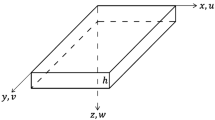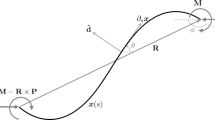Summary
When a solid element experience large deformations, the components of stress will, in general, vary as a result of material rotation. These changes occur even in the absence of additional strain, and need to be accounted for in formulating constitutive laws that involve the rate of change of stress. In this paper the correction terms are extended to the case when material axes become strongly skewed. An expression for the rate of material rotation as an explicit function of vorticity, rate of deformation and stretch is derived. It is then shown that the rate of change of stress depends on the rate of material rotation. As an example, expressions for material rotation and stress are derived for a hypoelastic material undergoing uniform, rectilinear, shear. The shear stress is compared with a solution that neglects skewing of the axes, and it is found that, for the example, skewing may be neglected for strains less than 0.4. Finally, the use of these relations in numerical calculations involving finite deformation is discussed.
Zusammenfassung
Wenn ein Festkörper große Verformungen erfährt, werden sich die Spannungskomponenten im allgemeinen als Folge der Materialrotation ändern. Diese Veränderungen treten sogar in Abwesenheit zusätzlicher Verzerrung auf, und müssen bei der Formulierung der Zustandsgleichungen, welche die Rate der Spannungsänderung berücksichtigen, in Betracht gezogen werden. In dieser Arbeit werden die Korrekturglieder erweitert zu dem Fall, wenn die materialachsen stark schräg zueinander werden. Abgeleitet wird ein Ausdruck für die Werkstoffrotationsgeschwindigkeit als eine explizite Funktion der Wirbel, Verformungs-und Ausdehnungsgeschwindigkeit. Es wird dann gezeigt, daß die Änderung der Spannung von der Materialrotationsgeschwindigkeit abhängig ist. Als Beispiel werden Ausdrücke für Werkstoffrotation und Spannung für einen hypo-elastischen Werkstoff, der gleichförmigen, geradlinigen Schub aufweist, hergeleitet. Die Schubspannung wird mit einer Lösung verglichen, die die Schräge der Achsen vernachlässigt, und es ergibt sich, daß, für dieses Beispiel, die Schräge für Verzerrungen weniger als 0,4 zu vernachlässigen ist. Abschließend wird die Anwendung dieser Beziehungen in numerischen Rechnungen für endliche Deformationen erörtert.
Similar content being viewed by others
References
Zaremba, S.: Sur une conception nouvelle des forces intérieurs dans un fluide en mouvement. Mém. Sci. Math. No. 82 (1937).
Zaremba, S.: Sur une forme perfectionnée de la théorie de la relaxation. Bull. Int. Acad. Sci. Cracovie1903, 594–614.
Jaumann, G.: Geschlossenes System physikalischer und chemischer Differentialgesetze. Sitzber. Akad. Wiss. Wien (IIa)120, 385–530 (1911).
Thomas, T. Y.: Kinematically Preferred Coordinate Systems. Proc. Nat'l. Acad. Sci. U. S.41, 762–770 (1955).
Noll, W.: On the Continuity of the Solid and Fluid States. J. Rat'l Mech. Anal.4, 3–81 (1955).
Cotter, B. A., Rivlin, R. S.: Tensors Associated with Time-dependent Stress. Quart. Appl. Math.13, 177–182 (1955).
Oldroyd, J. G.: On the Formulation of Rheological Equations of State. Proc. Roy. Soc. (London)A 200, 523–541 (1950).
Truesdell, C.: Corrections and Additions to “The Mechanical Foundations of Elasticity and Fluid Dynamics”. J. Rat'l Mech. Anal.2, 593–616 (1953).
Prager, W.: An Elementary Discussion of Definitions of Stress Rate. Quart. Appl. Math.18, 403–407 (1961).
Eringen, A. C.: Mechanics of Continua. Wiley. 1967.
Truesdell, C., Noll, W.: Non-Linear Field Theories of Mechanics, in: Handbuch der Physik, III/3. Berlin-Heidelberg-New York: Springer. 1965.
Sedov, L. I.: Different Definitions of the Rate of Change of a Tensor. Prikl. Mat. i. Mekh.24, 393–398 (1960).
Naghdi, P. M., Wainwright, W. L.: On the Time Derivative of Tensors in Mechanics of Continua. Quart. Appl. Mech.19, 95–109 (1961).
Masur, E. F.: On the Definition of Stress Rate. Quart. Appl. Math.19, 160–163 (1961).
Zhong-Heng, G.: Time Derivative of Tensor Fields in Non-Linear Mechanics. Arch. Mech. Stos.1, 131–161 (1963).
Bolder, H.: Deformation of Tensor Fields Described by Time-Dependent Mappings. Arch. Rat. Mech. Anal.35, 321–340 (1969).
Osias, J. R., Swedlow, J. L.: Finite Elasto-Plastic Deformation. Int. J. Solids Structure10, 321–339 (1974).
Willis, J. R.: Finite Deformation Solution of a Dynamic Problem of Combined Compressive and Shear Loading for an Elastic-Plastic Half-Space. J. Mech. Phys. Solids23, 405–419 (1975).
Stören, S., Rice, J. R.: Localized Necking in Thin Sheets. J. Mech. Phys. Solids23, 421–441 (1975).
Green, A. E., McInnis, B. C.: Generalized Hypo-Elasticity. Proc. Roy. Soc. EdinburghA 57, Part III, 220–230 (1967).
Dienes, J. K., Walsh, J. M.: Theory of Impact: Some General Principles and the Method of Eulerian Codes, in: High-Velocity Impact Phenomena. Academic Press. 1970.
Dienes, J. K.: Explosions in Anisotropic Materials, to be published.
Truesdell, C.: Hypo-elasticity. J. Rat. Mech. Anal.4, 83–133 (1955).
Truesdell, C.: The Kinematics of Vorticity. Indiana University Press. 1954.
Bellman, R.: Introduction to Matrix Analysis. McGraw-Hill. 1960.
Truesdell, C.: The Elements of Continuum Mechanics. Berlin-Heidelberg-New York: Springer. 1966.
Flugge, W.: Tensor Analysis and Continuum Mechanics. New York: Springer. 1972.
Dienes, J. K.: A High-Pressure Kinematic Hardening Model for Rocks and Soils. Jour. Geoph. Res.80, 3749–3754 (1975).
Wilkins, M. L.: Calculation of Elastic-Plastic Flow in Methods in Computational Physics, Vol. 3. New York-London: Academic Press. 1964.
Author information
Authors and Affiliations
Additional information
With 1 Figure
Rights and permissions
About this article
Cite this article
Dienes, J.K. On the analysis of rotation and stress rate in deforming bodies. Acta Mechanica 32, 217–232 (1979). https://doi.org/10.1007/BF01379008
Received:
Issue Date:
DOI: https://doi.org/10.1007/BF01379008




